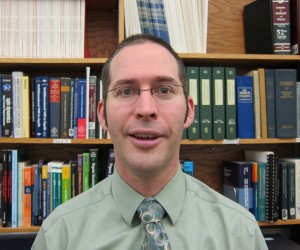He began college as a computer programming major, but Scott Burt knew he’d found his calling as soon as he took he took his first organic chemistry class.
“I read that o-chem book like it was a science fiction novel,” he said.
An assistant teaching professor in the Department of Chemistry and Biochemistry, Burt has only been out of graduate school for six years and is already being published in a leading research journal, an honor that many scientists do not achieve within their entire career. Though this is a huge step for his career, Burt is always striving to balance his work as a researcher with his roles as a mentor and a father.
On Oct. 24, Burt and a group of researchers from UCLA were published in Nature, one of the top research journals in the world. The article shows how the researchers were able to use MRI techniques, which is better known for its role in medical diagnostics, to map the temperatures of gases in heterogeneous reactions.
“This is the first time that MRI has been used to directly measure the temperature of the reacting gases,” Burt said. “Being able to measure temperature at the gas-solid interface is huge.”
The research was also important because it showed trends in the gas particle behavior opposite from current theories about the temperature dependence of MRI signals.
This article is the product of several years of work stemming from initial experiments Burt performed with his colleagues in graduate school at UC–Berkeley.
“Louis Bouchard and I ran the initial para-hydrogen microreactor experiments together,” Burt said. “After Louis started his research at UCLA, we continued to collaborate on the para-hydrogen project.”

(Photo courtesy Department of Chemistry and Biochemistry)
Burt attributes much of his success to influential teachers who taught him how exciting it could be to discover the physical world.
“When you’re in school, it seems like everything is understood,” he said. “That’s as far from the truth as possible. There are so many things we don’t understand yet.”
As a professor and BYU’s NMR (Nuclear Magnetic Resonance) Facility manager, Burt has used his passion for learning to help students discover their passion for chemistry as well.
“Scott is extremely helpful and enthusiastic about teaching students how to solve these chemical puzzles,” said chemistry professor Steve Castle. “In almost 20 years as an organic chemistry researcher, I have worked with several NMR spectroscopy experts. I have never worked with anyone who is as passionate about helping students learn spectroscopy as Scott is.”
His colleagues are not the only ones who have noticed his compassionate teaching methods; many of his students and young colleagues also note how much they have appreciated his individualized attention toward each person he interacts with.
“He is very kind, friendly and willing to help people even if he is busy with his work … he will sit with new students or faculties for hours and teach them with tremendous patience,” said Shenglou Deng, a post-doctoral fellow and adjunct professor in the Department of Chemistry and Biochemistry.
Even more important than being an attentive teacher, Burt values his role as a husband and father, titles he will have long after his days as a scientific researcher are behind him. He and his wife, Stephanie, have three young children, and his wife works as a chemical engineer, so the two have to share many responsibilities.
“It takes a lot of communication,” Burt said. “We have lots of demands on our time, so it becomes a matter of trading off.”
Though he has many responsibilities as a mentor, husband, father and scientific researcher, Burt strives to find harmony between each of his roles, and his efforts do not go unnoticed.
“Dr. Burt is a true family man,” said former undergraduate student Matt Neilsen. “As a Berkeley graduate, he could have chosen to work at a much more prestigious institution, but I think he has found the perfect balance between work and family at BYU, and the department is fortunate to have him.”




